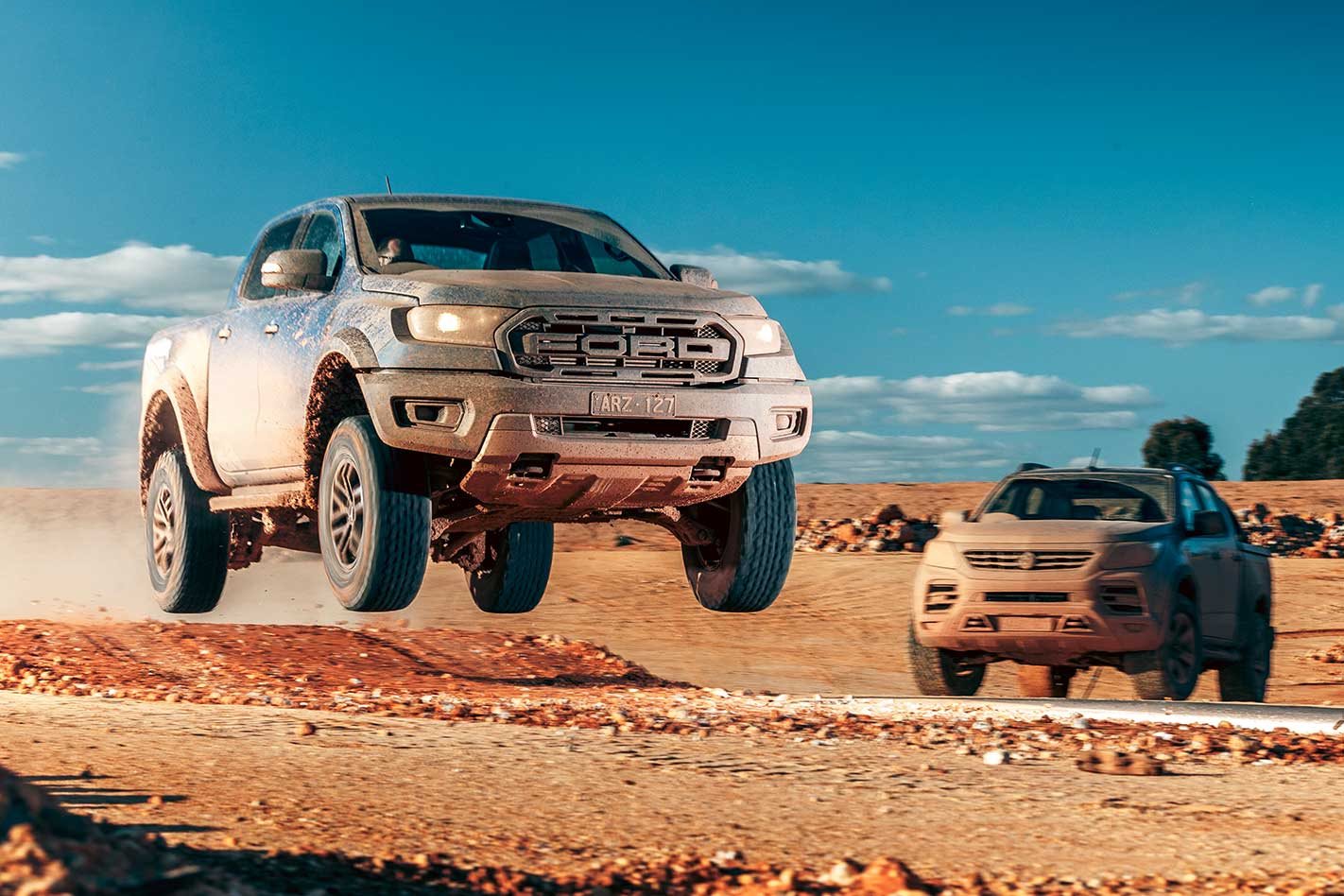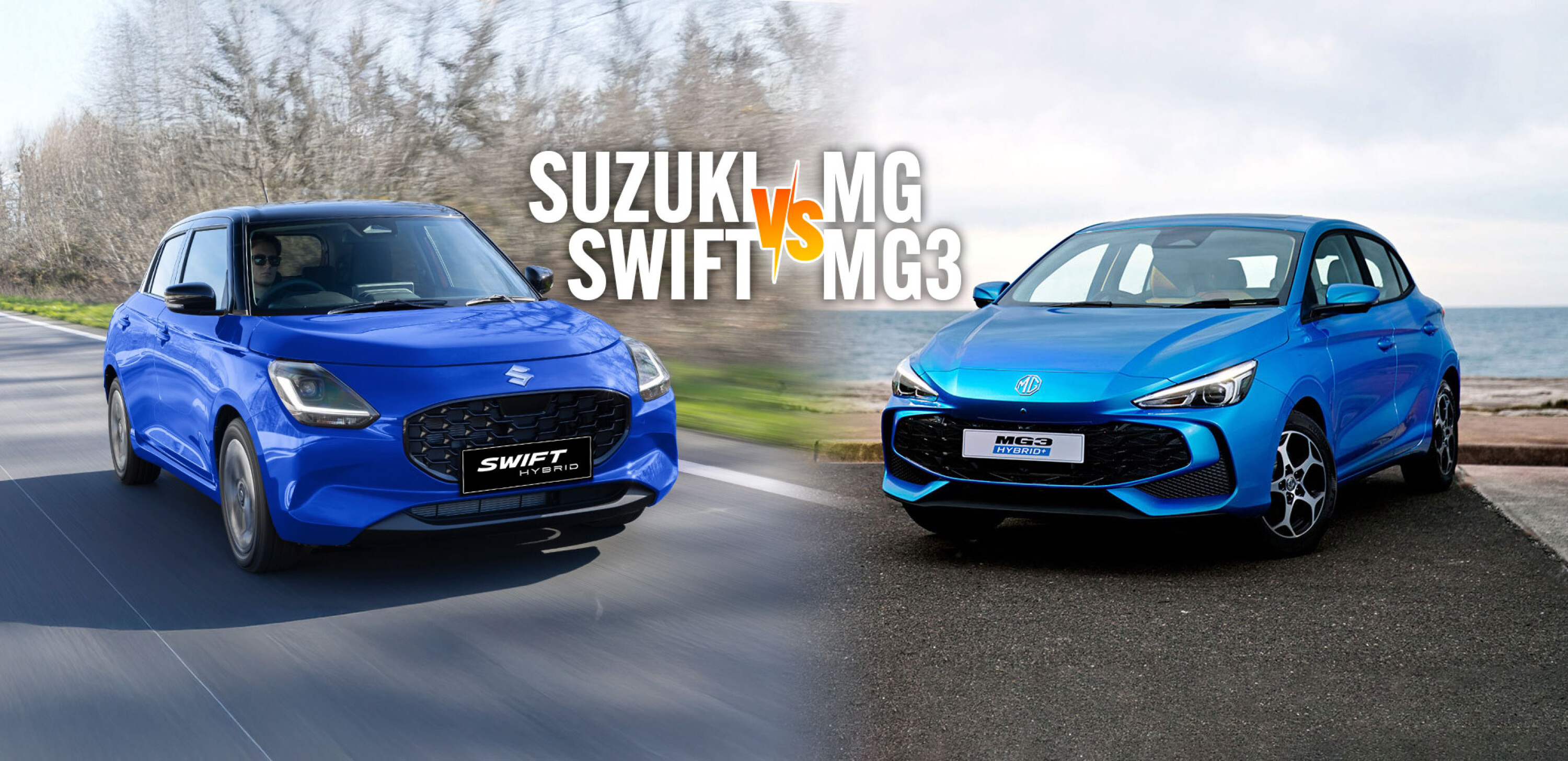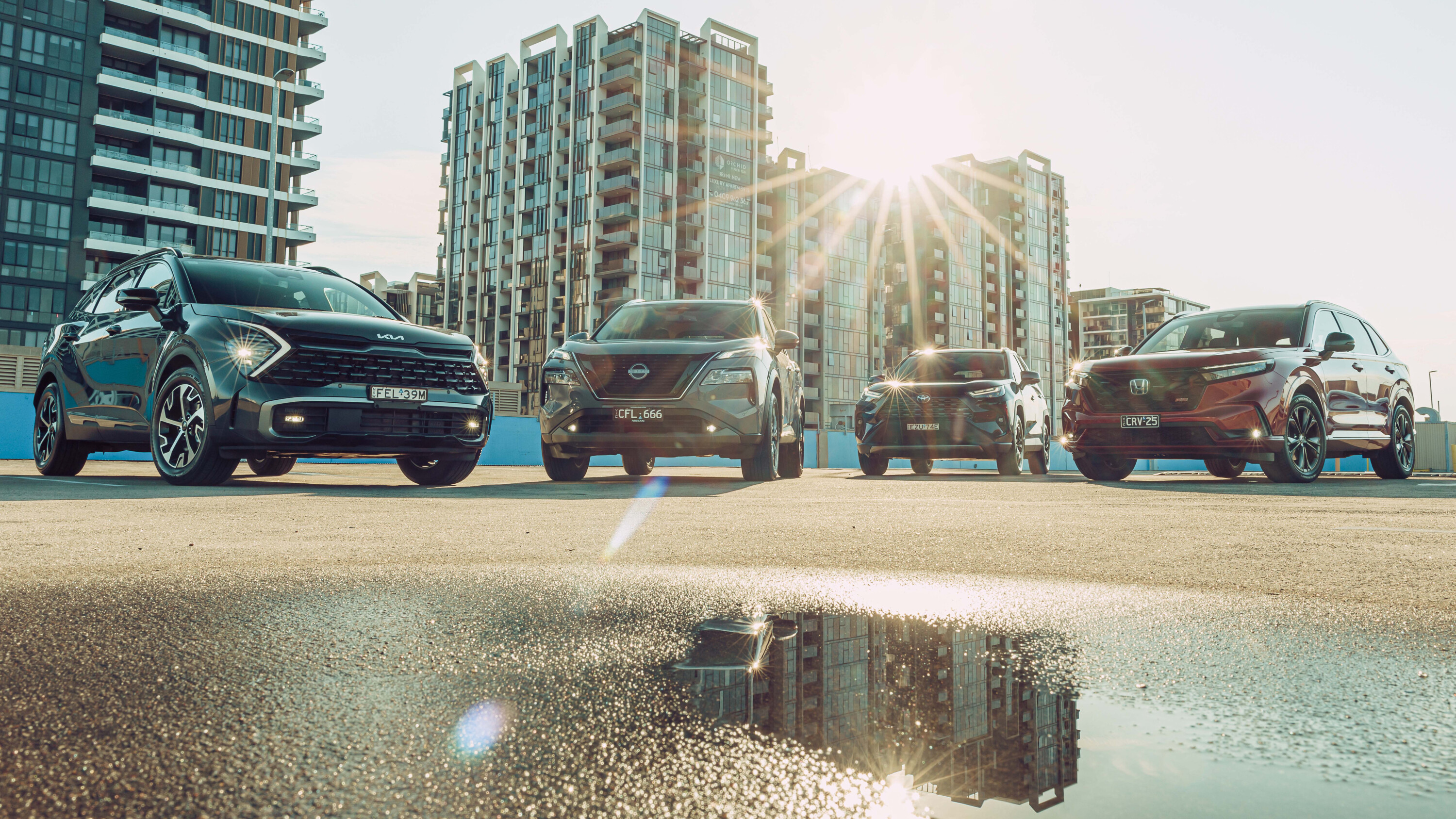What is a performance car? Traditionally the term has referred to something fast and agile, low-slung and sporty, but perhaps it’s time to rethink the definition. After all, what is performance?
Is the power of a weightlifter or endurance of a cross-country skier any less impressive than the outright speed of a 100m sprinter? Icons like the Mazda MX-5 and Peugeot 205 GTI, as well as the recent acceptance of fast SUVs, prove that car fans can be a broadminded bunch, but surely calling a diesel ute a performance car is stretching the elasticity of the term to breaking point?
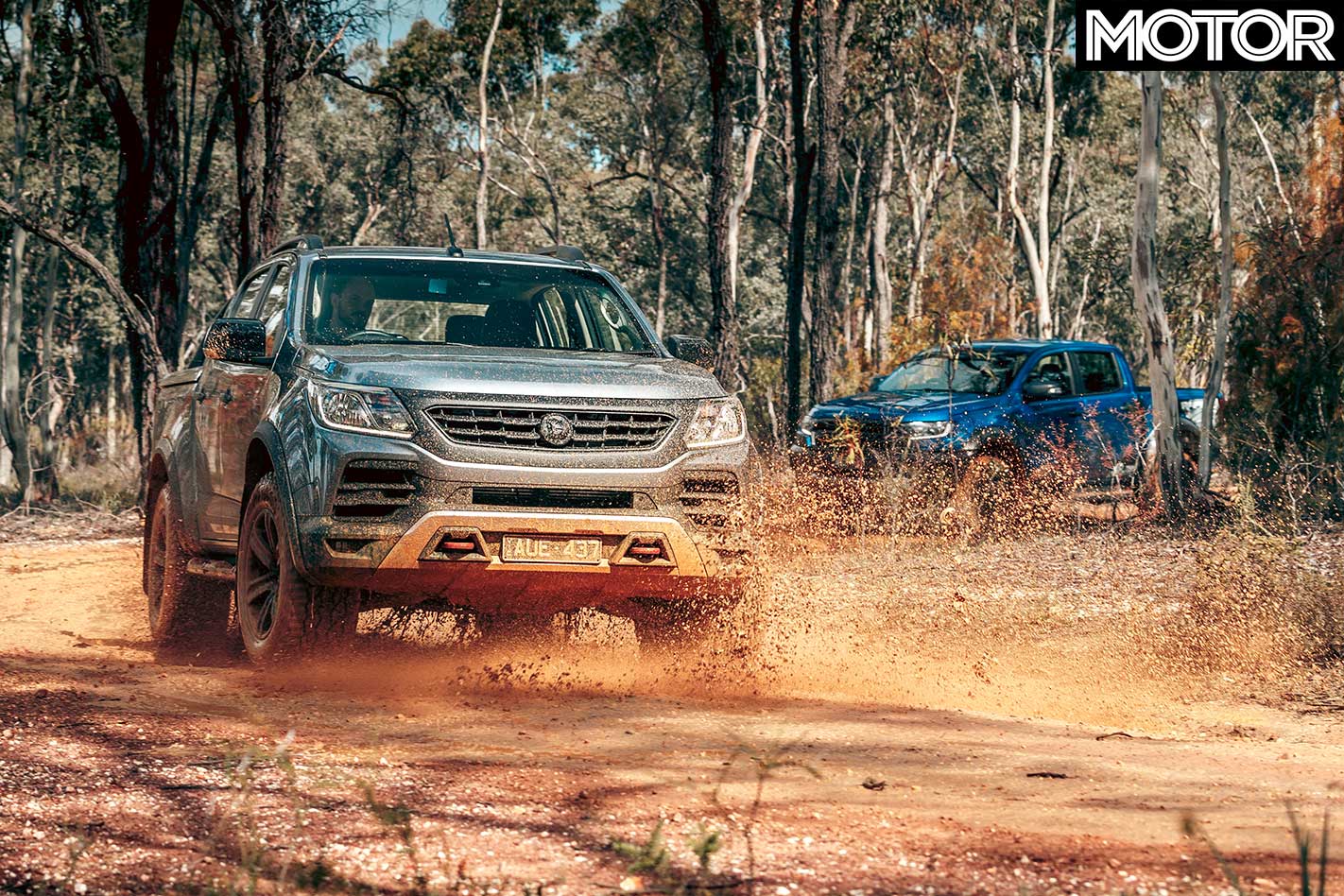
Ford and HSV disagree. They say their latest offerings, the Ranger Raptor and Colorado SportsCat respectively, are part of a new generation of performance and it’s enthusiast mindsets that need to change.
We debated long and hard whether to do this test. Were these tweaked tradie trucks simply too slow? Would readers be dismissive or, worse, insulted that the pages of MOTOR were sullied by jacked-up oil burners? In the end, the popularity of the dual-cab segment and our own curiosity led to the conclusion that we at least had to drive them and let the products speak for themselves. As such, this isn’t just a comparison but an acid test for the ‘performance truck’ segment – can diesel utes be fun?
HSV hit the market first with the ‘Holden Colorado SportsCat by HSV’. For reasons of brevity, it’ll be referred to here as the HSV SportsCat. It’s unchanged under the bonnet, retaining the 147kW/500Nm (440Nm as a manual) 2.8-litre four-cylinder turbo-diesel, but there’s revised suspension, specially engineered Cooper Zeon tyres wrapped around 18 x 10.0-inch alloys, recalibrated electronics, more aggressive styling and a jazzed-up interior with suede, leather and new seats.
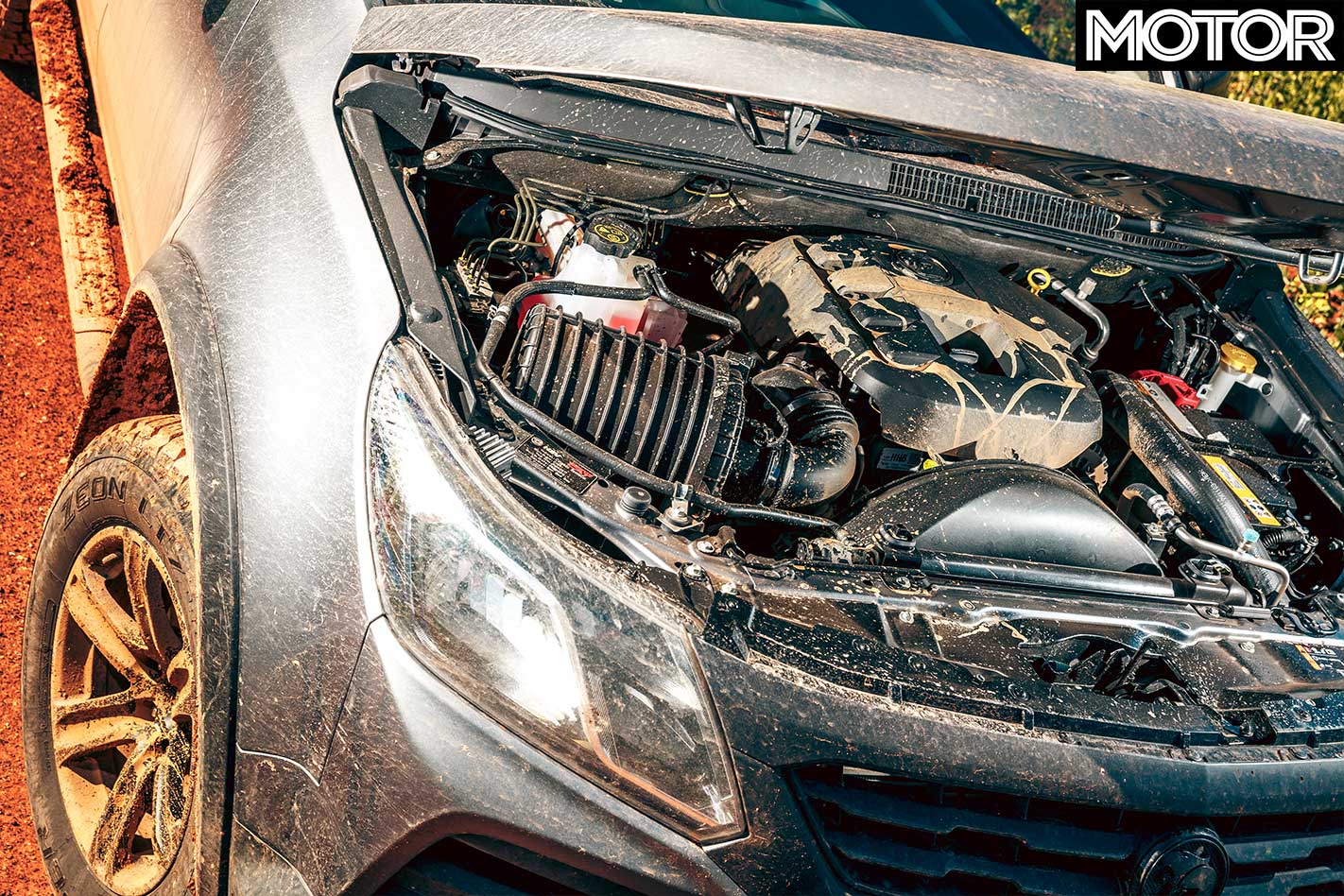
It’ll set you back $60,790 as a manual or $62,990 for the automatic tested here. We requested the higher-spec SportsCat+, which adds even angrier styling, larger brakes, a rear anti-roll bar and the option of trick SupaShock dampers, but sadly HSV did not have one available.
Its higher specification and price ($72,590 when optioned with an automatic and SupaShocks) would better match the $74,990 Ranger Raptor, but as it stands the Ford carries a significant price disadvantage. Its butch stance offers some compensation, its pumped guards gifting it the Mr Olympia title and relegating the Colorado to Mr Universe.
The Raptor also scores significant points inside, with more supportive seats, better materials – the aluminium shift paddles are beautiful – more up-to-date tech and a far superior driving position. Both lack steering wheel reach adjustment, but the Colorado’s seats are perched high, whereas the Ranger positions you low behind a wheel redolent of a modern Falcon.
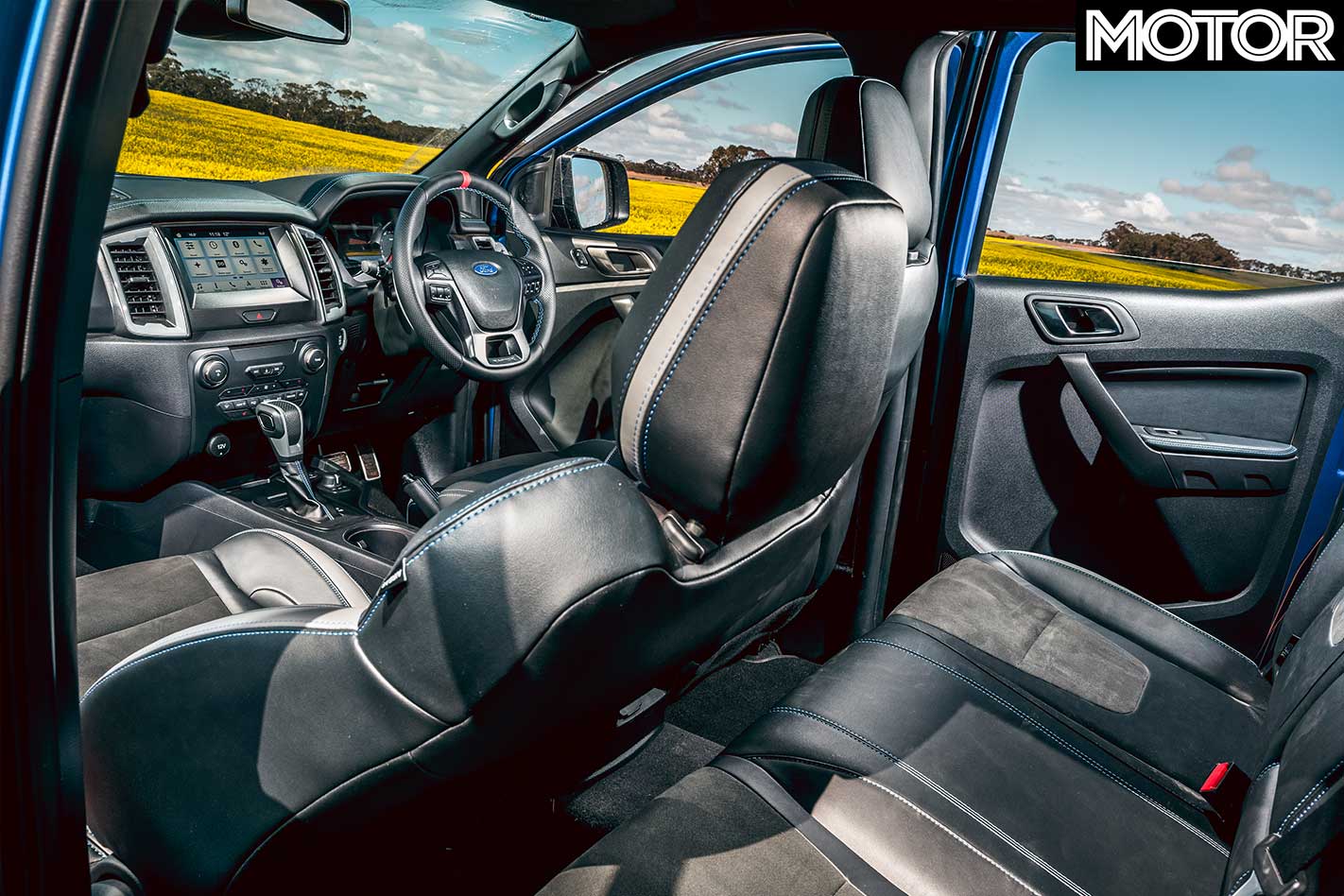
It’s under those swollen guards, though, where Ford spent the real money. Off-road suspension wizards FOX supply the dampers, while the standard Ranger’s leaf-sprung rear end is ditched for a Watt’s link setup that cuts towing ability to 2500kg, a tonne less than the Colorado. Brakes are discs all ’round, but the giant 285/70 BF Goodrich All-Terrains don’t bite into tarmac like they do dirt, the Raptor taking 43.9m to stop from 100km/h in a flurry of ABS.
Despite the Colorado’s humble disc/drum setup, its more road-focused Coopers offer better purchase, the Holden stopping almost three metres shorter (40.97m) with a firmer, more feelsome pedal. Likewise, the Holden’s ‘big block’ 2776cc diesel donk might not be the latest and greatest, but it’s enough to see off Ford’s whizz-bang new 2.0-litre twin-turbo unit. However, some context is required.
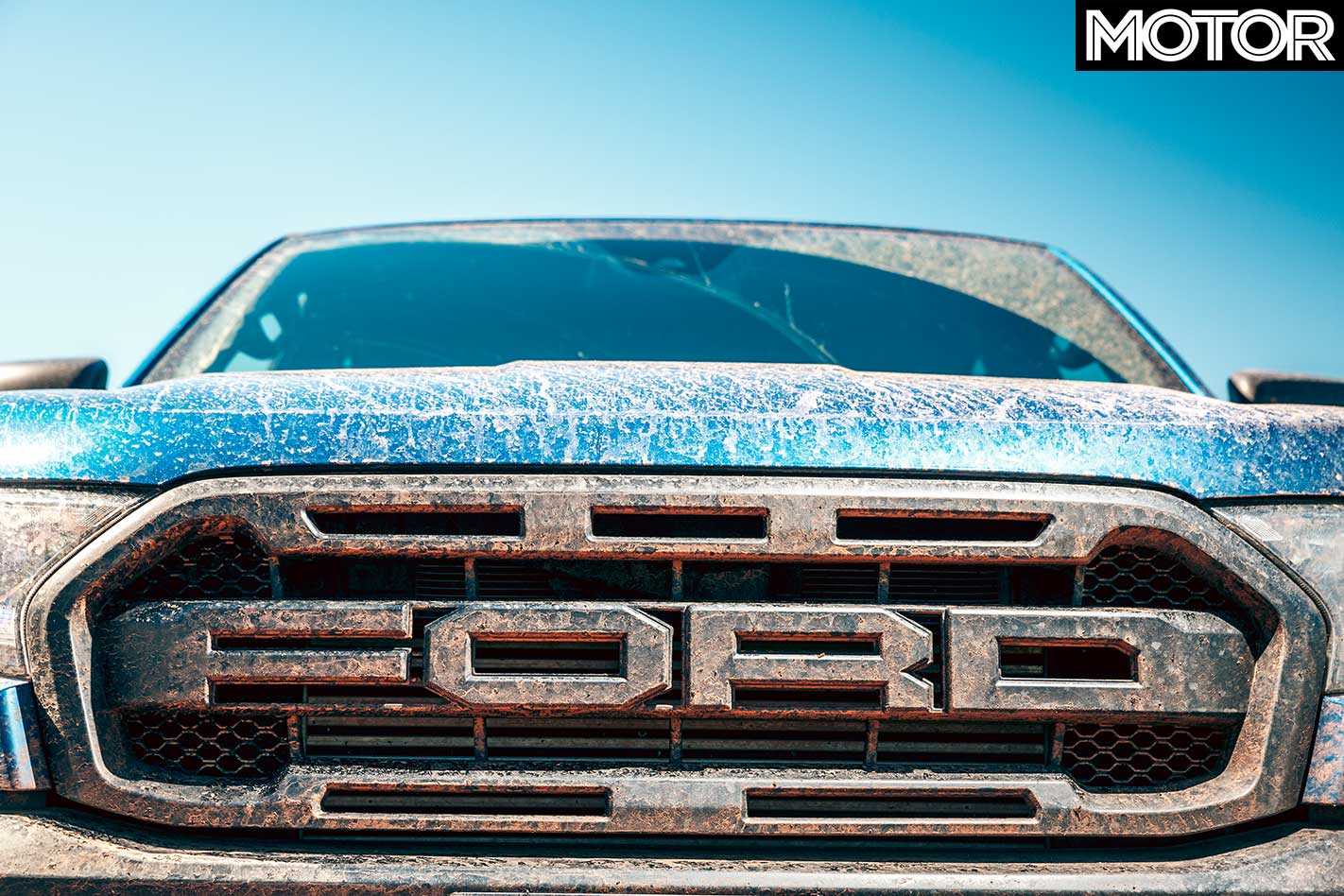
No-one is likely to buy one of these monsters for their engines and nor should they, because both are glacially slow. By the time these two meander past 100km/h, the likes of an Audi R8 or Porsche 911 Turbo have more than doubled that speed.
The culprit is not difficult to identify; the SportsCat musters just 65kW/tonne, the Raptor little better at 70kW/tonne. There’s reasonable torque on offer, but both weigh well over 2000kg. A dig through the archives to discover the last time we tested a car this slow was abandoned with the discovery a base 2005 Suzuki Swift was still quicker.
Now your expectations are set, the numbers. The SportsCat chirps its way off the line and revs cleanly, if slowly, to around 4000rpm, taking 17.28sec to cover 400m at 127.16km/h and 10.31sec to reach 100km/h on its way there.
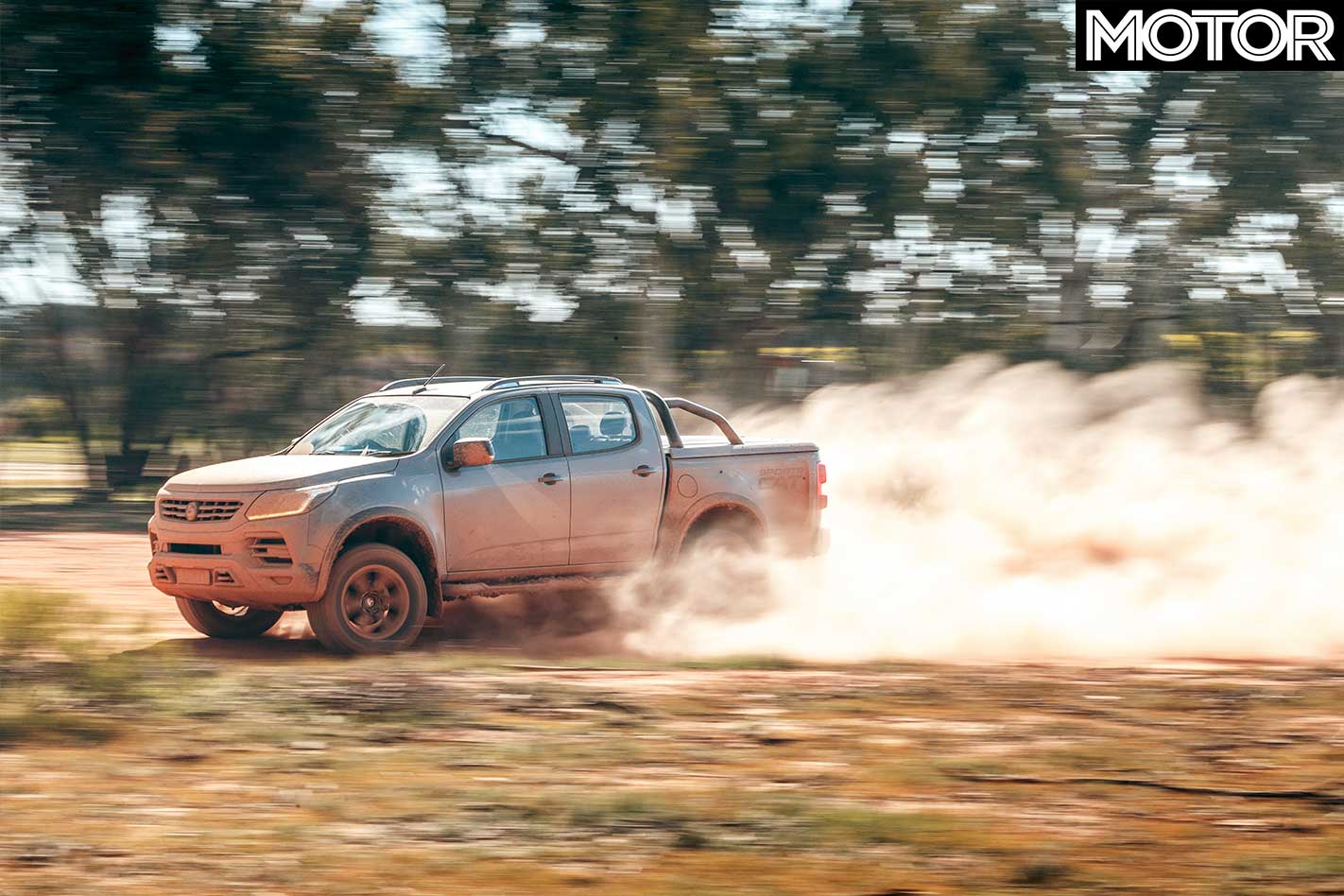
The Raptor trails the Colorado by two-tenths to 100km/h (10.54sec) and that it gets this close is a testament to its 10-speed automatic, which works valiantly to keep the engine in its limited sweet spot – using the paddles and the engine’s full rev range results in times half-a-second slower. Essentially, the two trucks are almost identical in speed, separated by just 0.31km/h at the end of the quarter mile.
On the road the Ranger improves. Under full load it emits a nice enough roar and selecting Sport sharpens throttle response. The gearbox is smooth, but on kickdown it can hesitate and try a couple of gears on for size before selecting the right one.
With only six gears to choose from, the Colorado doesn’t suffer the same indecision, but whereas the Ford’s 2.0-litre could almost pass muster in a sedan in terms of noise and refinement, the HSV is undeniably a truck.
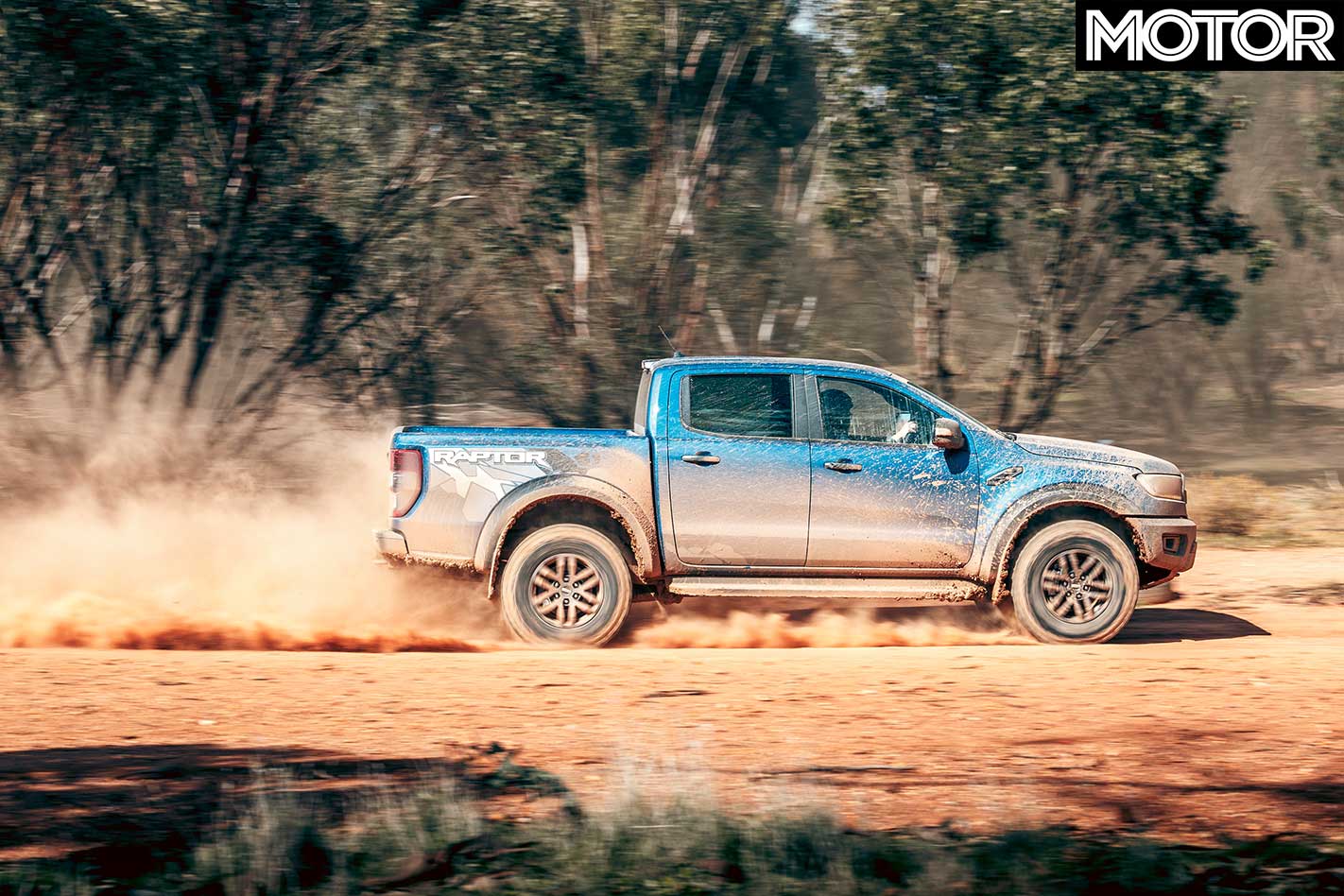
Similar comments apply to the touring ability of each. The SportsCat suffers from the body shimmy and jittery ride inherent in most dual-cab utes, fidgeting constantly on a typical country backroad. In contrast, the Raptor is a revelation.
There’s the occasional wobble from the rear end, but by and large the Ranger’s ride is remarkable, the combination of expensive suspension and those balloon-like tyres soaking up all manner of road imperfections. The penalty for this plushness is highly compromised on-road dynamics.
In building these utes, the two companies have adopted polar opposite handling approaches: HSV has attempted to broaden the Colorado’s appeal by improving its sealed surface abilities, while Ford has deemed this a fool’s errand and focused solely on making the Ranger as capable as possible off-road.
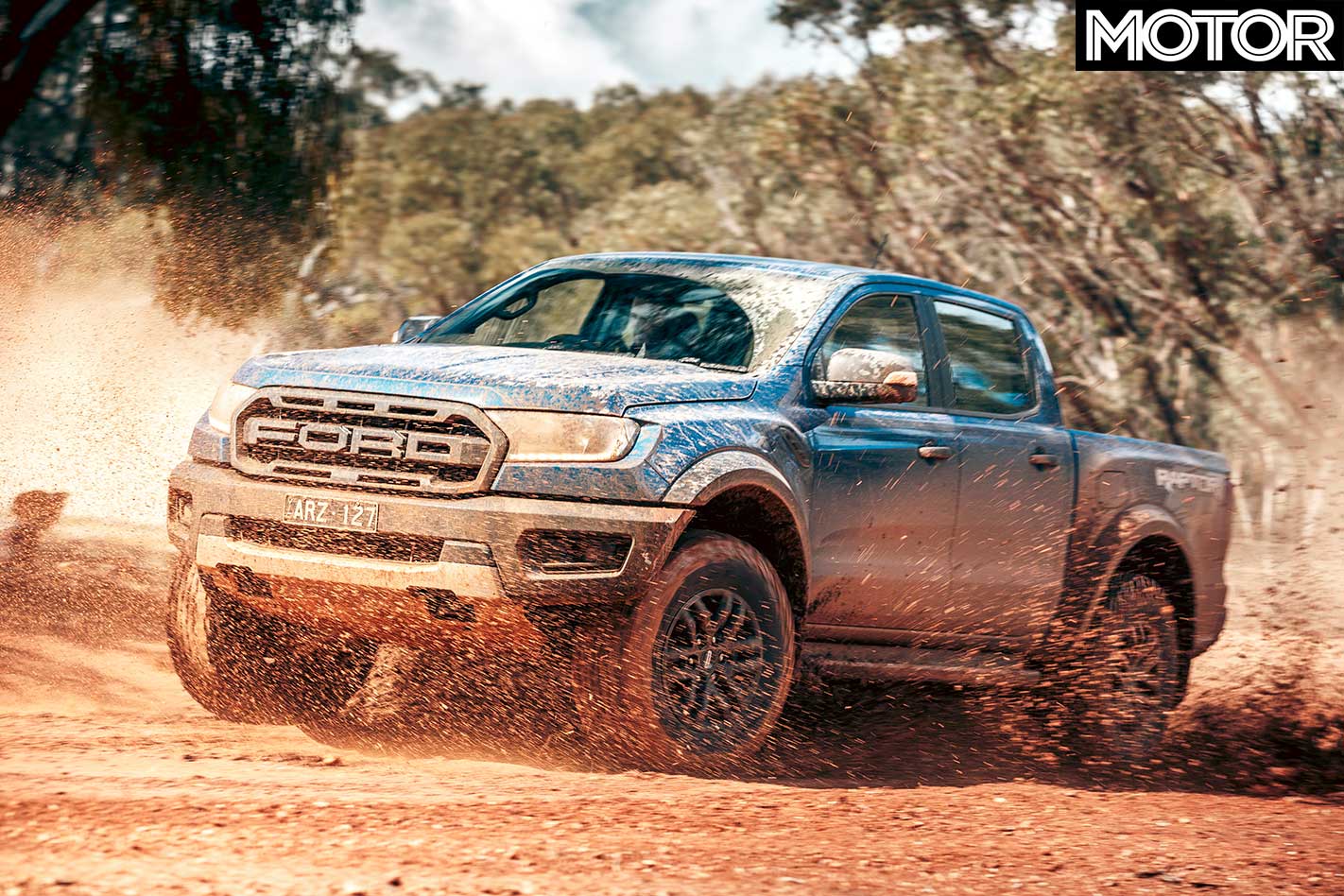
As a result, while it’s possible to hustle a Raptor on tarmac, it’s a largely pointless exercise. The steering is very nice, fluid and responsive with only slight low-speed wooliness, but cornering with any enthusiasm results in dogged early-onset understeer and the sorrowful howl of BF Goodrich rubber. Traction in the wet isn’t great, either; be wary of slick roundabouts.
In comparison, the HSV is a sharper tool, relatively speaking. The stiffer suspension setup pays dividends in its quicker responses and crisper turn-in, while the tyres inspire much greater confidence with surprising wet-weather grip.
HSV has thus effectively achieved its goal of improving the Colorado’s on-road behaviour, but that doesn’t answer our original question, for a SportsCat is not ‘fun’ on a sealed surface. Thankfully, our route through the Bendigo Regional Park and Kooyora State Park offers the opportunity to swap tarmac for gravel, traversing rock-strewn fire trails with deep washouts, narrow, sandy tracks and fast, open, rally-style roads.
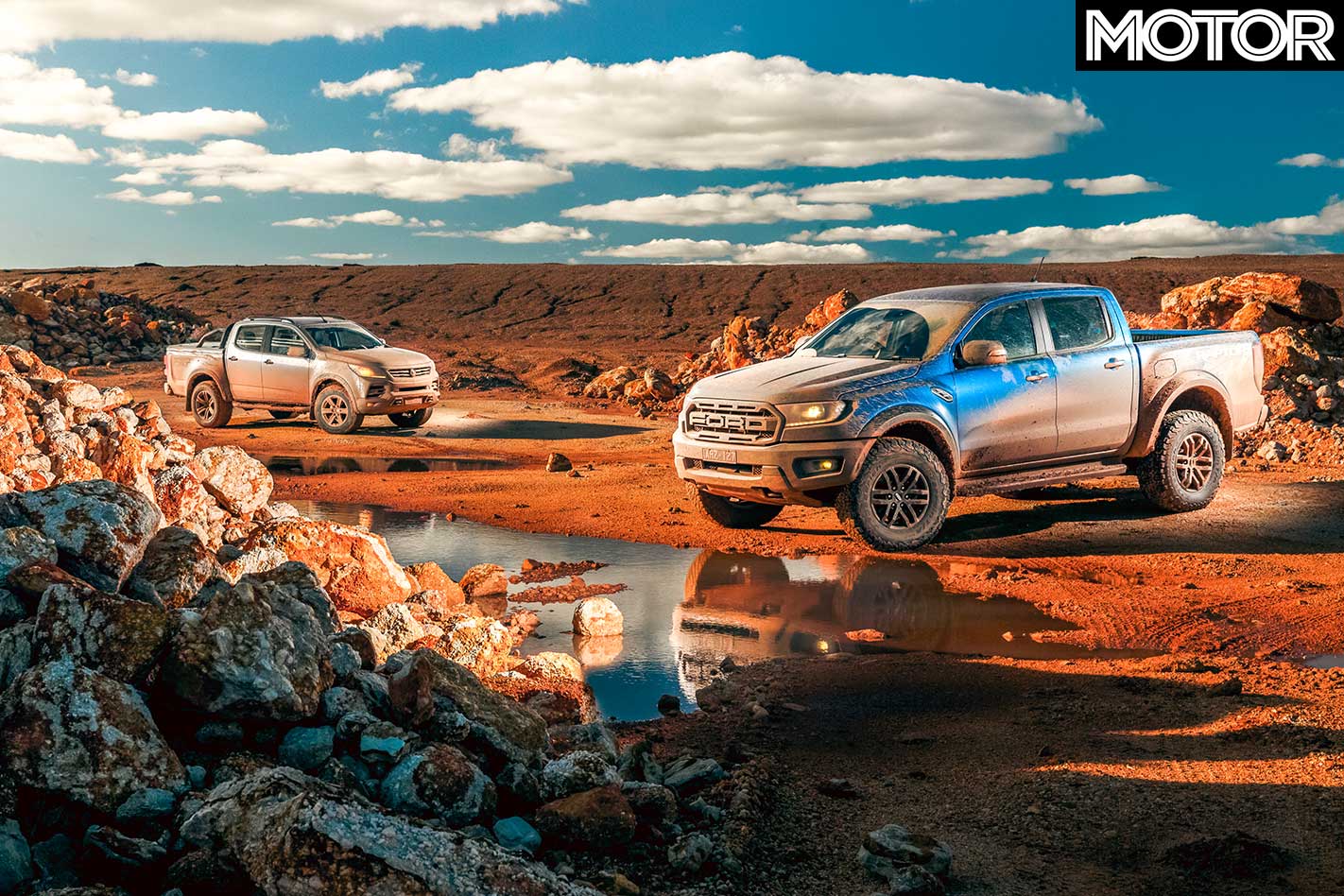
It’s here the HSV will put a smile on your face and for familiar reasons. The recipe is not complicated: a slippery surface, rear-wheel drive, limited-slip diff, 500Nm of torque, lots of steering lock and ESP that is happy to put its feet up and let the driver take control.
Throttle response isn’t amazing, but there’s enough grunt to get the rear-end swinging and enough traction from the deeply treaded tyres to retain control. The same is true of the Raptor with the bonus of quicker, more communicative steering, though its ESP isn’t as keen to take a back seat and the surplus of gears makes it harder for the auto to decide which ratio to hold a slide in.
A particularly gnarly stretch of forest road proves the brilliance of the Raptor’s FOX shocks. Bumps and compressions that send the stiffer SportsCat bouncing into the air and pogoing on landing are absorbed with nonchalance by the Ranger. You can drive over virtually everything at any speed and always retain control.
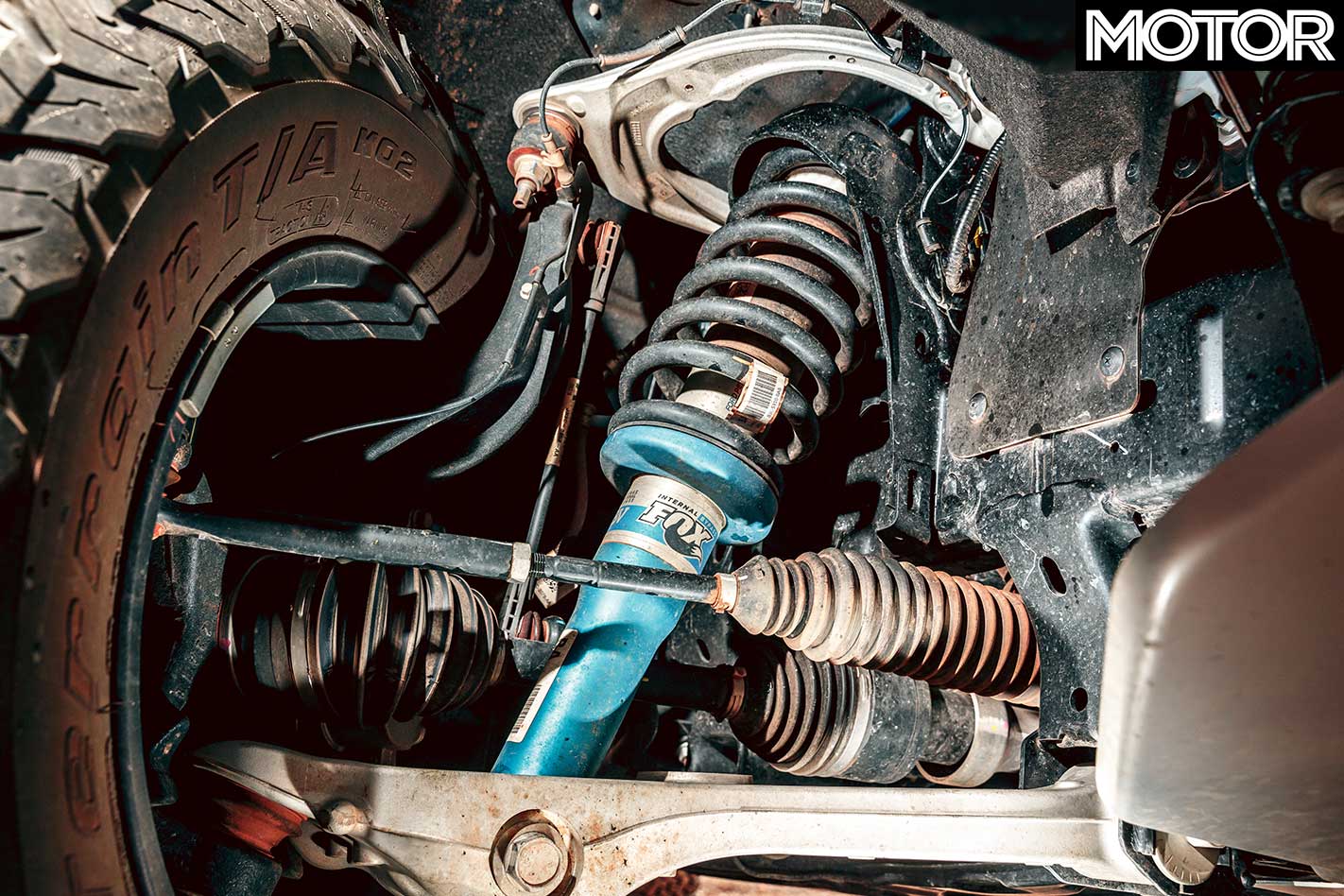
MOTOR isn’t the outlet to comment on the cars’ hardcore off-road credentials – we’ll leave that to our sister mag 4X4 Australia – but with low range gearing, locking rear diffs, chunky tyres and plenty of ground clearance (283mm for the Raptor, 251mm for the SportsCat) both seem capable of scaling most mountains and fjording most streams.
4×4 Comparison: SportsCat v Ranger Raptor
Our speciality is track testing, but while we aren’t going to make an exception for this pair simply because they sit higher and drink a different fuel to our usual test vehicles, we do need to alter the circuit characteristics somewhat, hence securing a private off-road circuit and the services of one of Australia’s top rally drivers, Brendan Reeves.

First up, the SportsCat, and DC and I take a large step backwards as Brendo seems to have forgotten where the brake pedal is, pitching into the long sweeper at the end of the straight at top speed, the SportsCat bouncing and squirming as it wages a furious battle with physics. Three laps later the HSV in all-wheel drive has managed a 1:24.2, a time around 12 seconds slower than Brendo’s full-house WRX STi rally car – not bad.
“It didn’t feel uncomfortable on the rally track,” explains Reeves. “There are a few bumps out there and I was nervous about hitting them sideways in such a high, heavy vehicle but it absorbed them well. Turn-in was quite good, I was able to get a bit of oversteer on the way into corners which was nice. In the twisty stuff the stability was good, I was able to hold the slide well; in high-speed corners the rear was rolling around a lot, but it never felt like it was going to tip over, I’d just apply more throttle to straighten it out.”

With the benchmark set, Brendo straps into the Raptor. It looks more composed from outside and theoretically its off-road focus should make it quicker, a hunch confirmed by its 1:23.7 lap time, half-a-second up on the HSV.
A quick confession: Brendo’s main complaint was the Ranger’s dead throttle response, which would have been solved by selecting Baja mode. Unfortunately, we didn’t know how to access it at the time and were on a very tight schedule, however, the Raptor benefited from a slightly drier track so the time difference is probably about right, give or take a tenth or two.
“I felt more comfortable to push harder, purely because of the suspension,” says Reeves. “In the high-speed corners the Raptor’s definitely nicer, you can really tip it in like a rally car. The speeds felt similar down the straight but when I jumped on the brakes it takes a bit longer to pull up and the pedal’s a bit softer as well.”
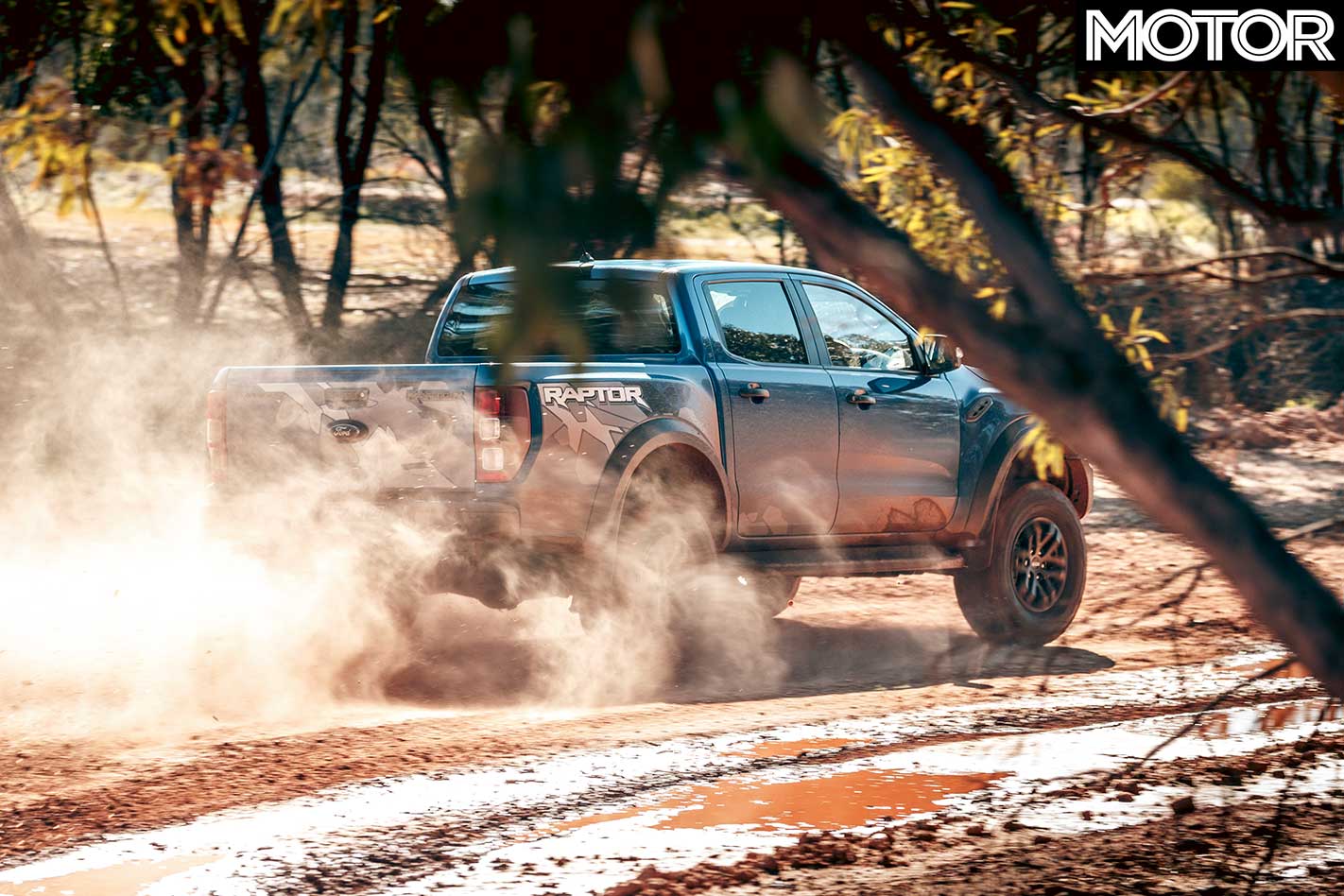
Brendo’s other Raptor bugbear was constant electronic intervention when it started to slide. After two days of experimentation with the various modes it appears that the ESP can be completely deactivated up to around 80km/h, but beyond that speed it reverts to a sort-of ‘Sports’ mode and will remain that way even if you slow down again.
The system is extremely well calibrated, allowing enough lateral movement to require opposite lock without intervening too harshly. On the other hand, it’s disappointing that a performance car aimed at off-road use won’t let the driver fly solo, regardless of the mode selected.
Nonetheless, both are more capable and entertaining than you’d ever believe. There’s enough chassis adjustability to constantly alter the balance with the throttle or brake, all-wheel drive opens a window to quasi-rally car dynamics and rear-drive results in lurid oversteer slides.
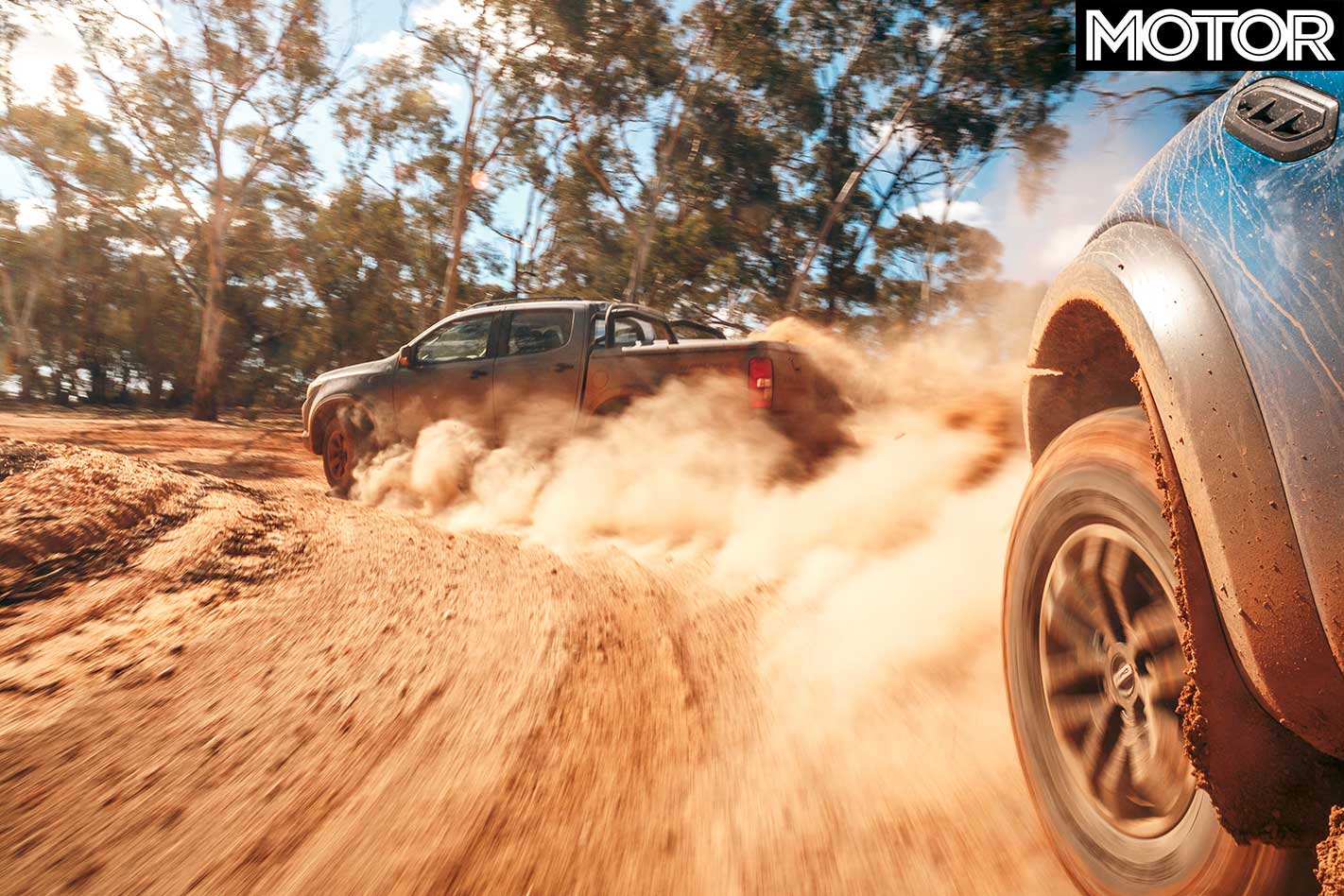
To back up Brendo’s comments, the Raptor feels absolutely in its element, but could use more finesse to its controls, particularly the brakes and throttle. The SportsCat has sharper responses and a stronger engine, but its firmer suspension and slower steering makes it a busier drive and it can’t soak up the same punishment as the Ford. Then again, it was never designed to.
So, can a diesel ute be a performance car? In terms of pure numbers, categorically not. However, if driving enjoyment is the criteria then both have something to offer – both DC and I agree we’ve had more fun on this shoot than any other in 2018.
Yes, that entertainment is available only in a very specific environment, but the same could be said of various track-day specials, which can’t carry five adults, tow a trailer and cart your rubbish to the tip.
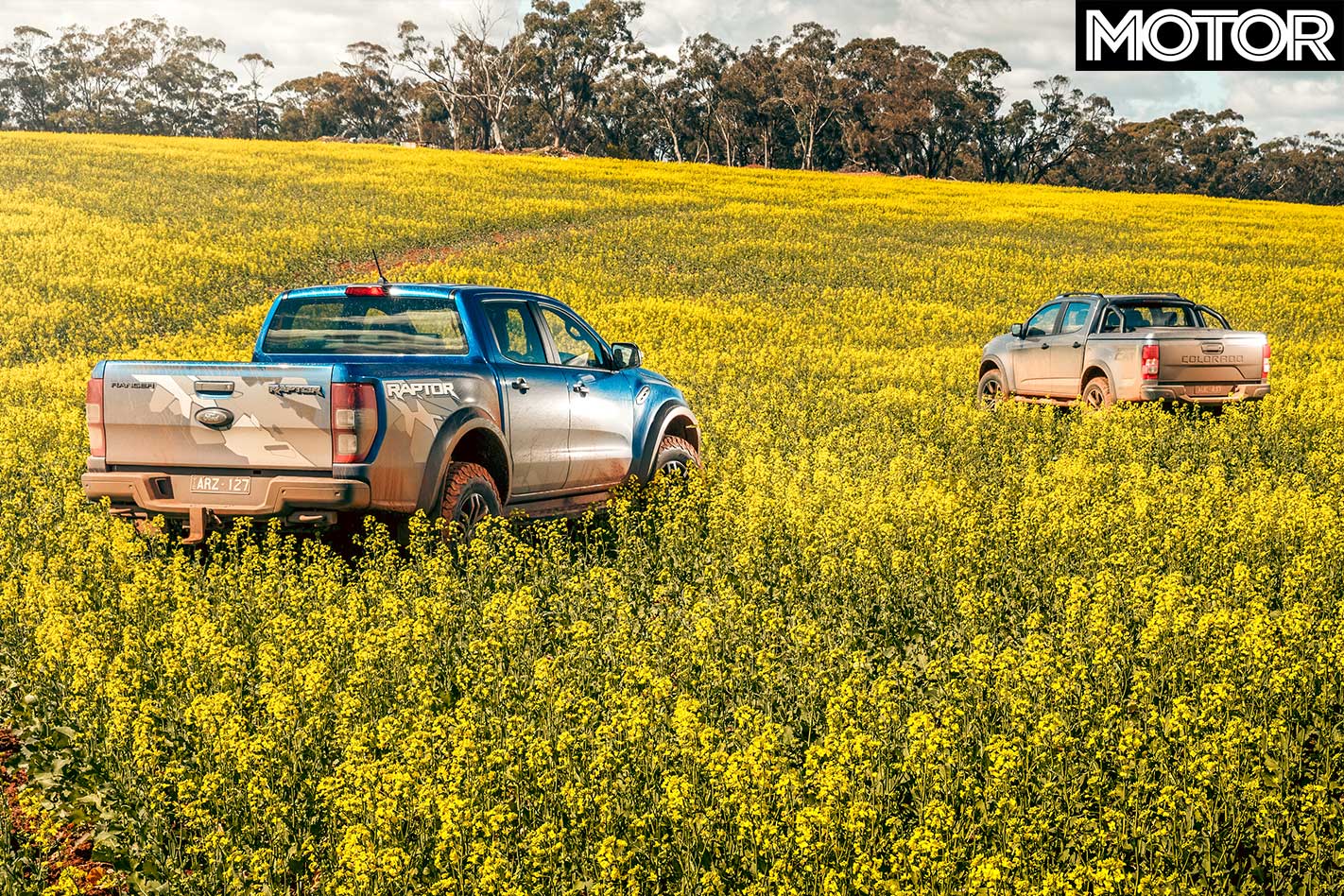
That settled, which is best? HSV’s engineering improvements are admirable, but the SportsCat is too compromised by the standard Colorado’s shortcomings – terrible driving position, lacklustre interior, restless ride – to win. The Ranger is simply a nicer car and in Raptor guise offers benchmark on-road comfort as well as remarkable high-speed off-road ability. It has everything except a proper powertrain.
It doesn’t need a V8 or even the F150’s twin-turbo V6, just a decent diesel. Perhaps a bespoke engine would’ve killed the program, but for a Ford Performance product to be three seconds slower to 100km/h than the category benchmark – the 200kW/580Nm VW Amarok Ultimate – doesn’t help its credibility.
The Ranger Raptor makes the strongest case yet for redefining performance cars, but a bit more grunt would seal the deal.
Second opinion
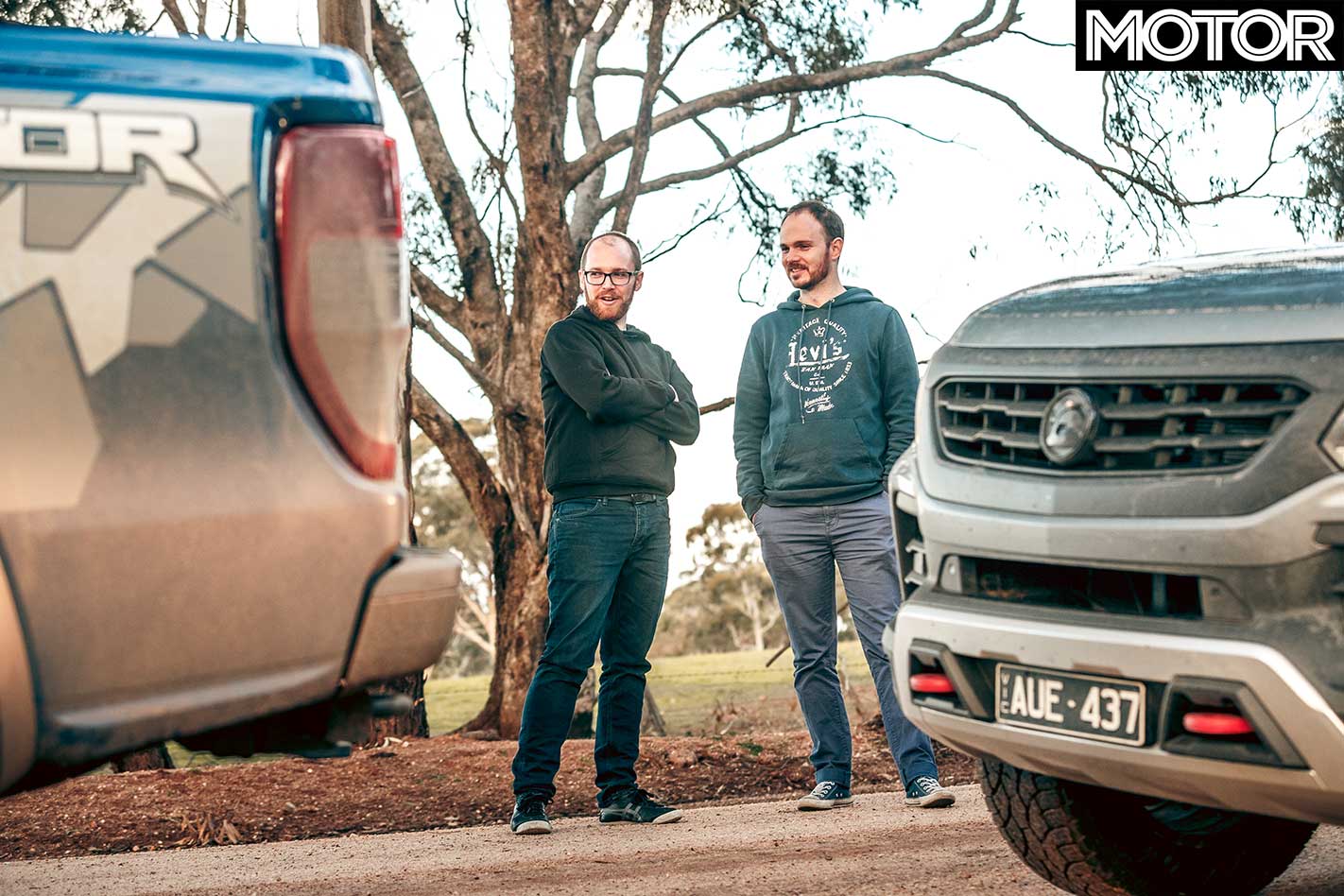
I’d take the Raptor. I think it looks cooler, it has a better driving position and it feels more complete to drive. Also the suspension is amazing; you can go so fast on the worst of roads. I was even more disappointed by the engine than expected; it, and the 10-speed auto, feel irritatingly sluggish. While a half turn opposite lock is possible, it’s a huge oversight that you can’t turn ESP completely off.
The Colorado is almost more fun in a tail-out way for this reason. But if the Raptor is closer to car, the Colorado feels closer to workhorse. There’s a chassis shimmy that never goes away, the front and rear ends don’t speak to each other. The suspension is surprisingly good, just overshadowed by the excellent Fox Racing set-up in the Ranger.
In many ways, the Raptor is to Colorado what VFII SS was to FGX XR8. – Dylan Campbell
Fast Facts
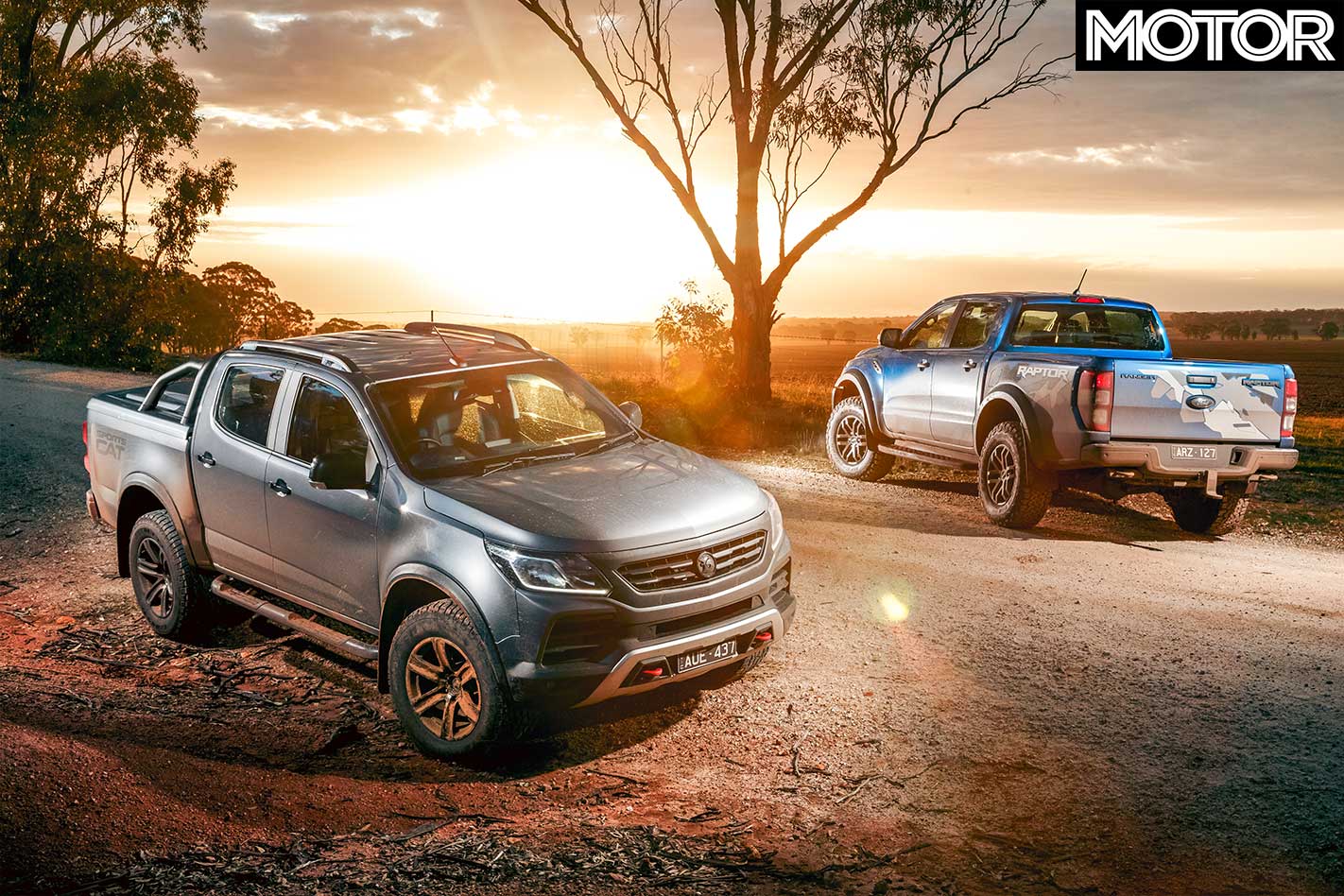
| u00a0 | HSV Colorado SportsCat | Ford Ranger Raptor |
| Body | 4-door, 5-seat ute | |
| Drive | rear- or all-wheel | |
| Engine | 2776cc inline-4cyl diesel DOHC, 16v, turbo | 1996cc inline-4cyl diesel DOHC, 16v, twin-turbo |
| Bore x Stroke | 94.0 x 100.0mm | 84.0 x 90.0mm |
| Compression | 16.5:1 | 16.0:1 |
| Power | 147kW @ 3600rpm | 157kW @ 3750rpm |
| Torque | 500Nm @ 2000rpm | 500Nm @ 1750-2000rpm |
| Power/Weight | 65kW/tonne | 70kW/tonne |
| Transmission | 6-speed auto | 10-speed auto |
| Weight | 2250kg | 2332kg |
| Suspension | double wishbones, coil springs (f); leaf springs (r) | struts, coil springs (f); Watts link, coil springs (r) |
| L/W/h | 5345/1933/1826mm | 5398/2025/1873mm |
| Wheelbase | 3096mm | 3220mm |
| Tracks | 1600mm (f/r) | 1710mm (f/r) |
| Steering | electrically-assisted rack-and-pinion | |
| Brakes | 300mm ventilated discs, 2-piston calipers (f); 295mm drums (r) | 332mm ventilated discs, 2-piston calipers (f); 332mm ventilated discs, single-piston calipers (r) |
| Wheels | 18.0 x 10.0-inch (f/r) | 17.0 x 8.5-inch (f/r) |
| Tyre Sizes | 285/60 R18 (f/r) | 285/70 R17 (f/r) |
| Tyres | Cooper Zeon LTZ | BF Goodrich All-Terrain K02 |
| Price | $62,990 | $74,990 |
| Pros | Impressive tyres; strong brakes; price | Amazing off-road ability; looks; interior |
| Cons | Unsettled ride; sub-standard interior | Deserves more grunt; brake feel; ESP confusion |
| Rating | 3 out of 5 stars | 3.5 ouf ot 5 stars |
The Strip

| u00a0 | HSV Colorado SportsCat | Ford Ranger Raptor | |
| 0-10km/h | 0.50sec | 0.65sec | |
| 0-20km/h | 1.01sec | 1.24sec | |
| 0-30km/h | 1.54sec | 1.92sec | |
| 0-40km/h | 2.39sec | 2.63sec | |
| 0-50km/h | 3.32sec | 3.53sec | |
| 0-60km/h | 4.31sec | 4.52sec | |
| 0-70km/h | 5.59sec | 5.70sec | |
| 0-80km/h | 6.97sec | 7.05sec | |
| 0-90km/h | 8.51sec | 8.69sec | |
| 0-100km/h | 10.31sec | 10.54sec | |
| 0-110km/h | 12.51sec | 12.72sec | |
| 0-120km/h | 15.02sec | 15.12sec | |
| 0-130km/h | 17.98sec | 18.36sec | |
| 0-400m | 17.28sec @ 127.16km/h | 17.48sec @ 127.47km/h | |
| 80-120km/h (Drive) | 8.05sec | 7.99sec | |
| 100-0km/h | 40.97m | 43.90m | |
| Speed in Gears | |||
| 1st | 52km/h @ 4500rpm | 40km/h @ 4500rpm | |
| 2nd | 89km/h @ 4500rpm | 63km/h @ 4500rpm | |
| 3rd | 137km/h @ 4500rpm | 88km/h @ 4500rpm | |
| 4th | 180km/h @ 4440rpm* | 107km/h @ 4500rpm | |
| 5th | 180km/h @ 3250rpm* | 124km/h @ 4500rpm | |
| 6th | 180km/h @ 2560rpm* | 148km/h @ 4500rpm | |
| 7th | N/A | 170km/h @ 4060rpm* | |
| 8th | N/A | 170km/h @ 3450rpm* | |
| 9th | N/A | 170km/h @ 2790rpm* | |
| 10th | N/A | 170km/h @ 2580rpm* | |
Heathcote Raceway, 13˚C, dry. Driver: Scott Newman *Manufacturer’s claim Official timing supplier – VBOX Australia
Gravel lap battle
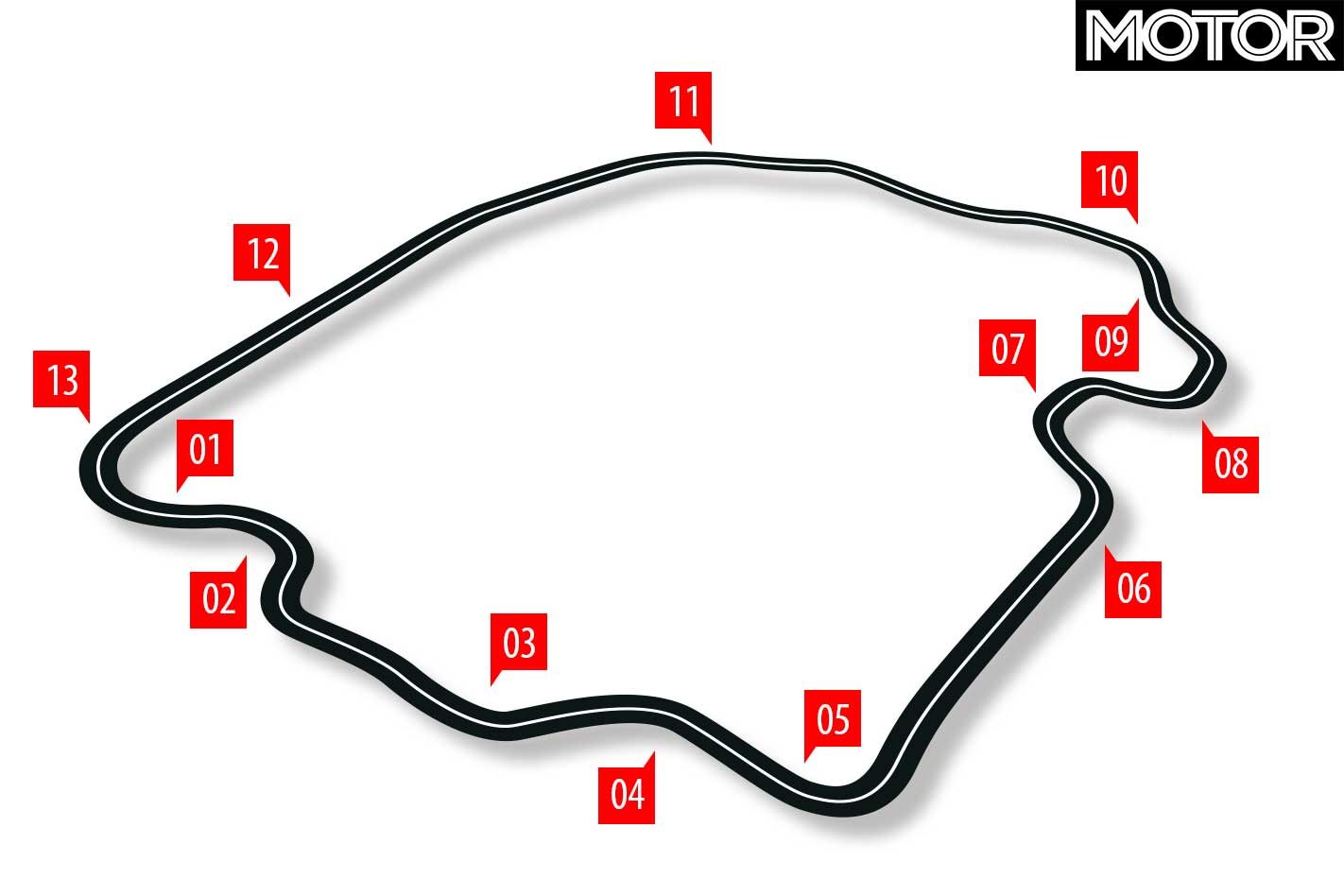
| SportsCat | Point | Raptor |
| 47km/h | 1 | 45km/h |
| 55km/h | 2 | 53km/h |
| 69km/h | 3 | 68km/h |
| 60km/h | 4 | 62km/h |
| 48km/h | 5 | 51km/h |
| 103km/h | Back straight | 105km/h |
| 54km/h | 7 | 50km/h |
| 52km/h | 8 | 56km/h |
| 35km/h | 9 | 38km/h |
| 55km/h | 10 | 58km/h |
| 95km/h | 11 | 95km/h |
| 126km/h | V-max | 126km/h |
| 58km/h | 13 | 58km/h |
| 1:24.2 | Lap Time | 1:23.7 |
Wedderburn, Victoria. 16˚C, dry. Driver: Brendan Reeves


